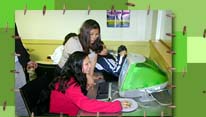|
Standards:
The following are standards taken from the California History-Social
Science Content Standards for California Public Schools and the
English-Language Arts Content Standards for California Public Schools.
They are all standards which are covered by this project. They can
be more emphasized and expanded by individual teachers.
History-Social Science Content Standards
Chronological and Spatial Thinking
1.Students compare present with the past, evaluating the consequences
of past events and decisions and determining the lessons that were
learned.
4.Students relate current events to the physical and human characteristics
of places and regions.
Historical Interpretation
1.Students show the connections, casual and otherwise, between particular
historical events and larger social, economic, and political trends
and developments.
4.Students understand the meaning, implication, and impact of historical
events and recognize that events could have taken other directions.
5.Students analyze human modifications of landscapes and examine
the resulting environmental policy issues.
11th Grade American History and Geography-Continuity and Change
in the 20th Century
11.11Students analyze the major social problems and domestic policy
issues in contemporary American society.
English-Language Arts Content Standards
Reading
2.0Reading Comprehension (Focus on Informational Materials)
- Students
read and understand grade level appropriate material.
- They
analyze the organizational patterns, arguments, and positions
advanced.
Listening
and Speaking Strategies
1.0They deliver focused and coherent presentations of their own
that convey clear and distinct perspectives and solid reasoning.
They use gestures, tone, and vocabulary tailored to the audience
and purpose.
Arts Standards
Inter: Re-Active utilizes three primary models for interdisciplinary
arts instruction: inquiry-based presentation, critical analysis,
and creative production. A representative sample of activities listed
below correspond directly to the Visual and Performing Arts Content
Standards for California Public Schools as indicated in parentheses.
1) Inquiry-based Presentations on the history of western
participatory art models provide students with information about
those works but also about the accompanying ideological, social
and economic histories of various art movements. Presentations on
the history of landscape, self-portraiture, and genre painting complemented
by presentations on contemporary artists work in new media will
facilitate studentsŐ manipulation of color, shape and spatial design
in their work (Artistic Perception: 1.6: Compare and contrast
similar styles of art work done in electronic media with those done
in traditional visual arts materials)
2) Critical analysis of various art works emphasize written
and oral critiques through which students will explain their understanding
and appreciation of contemporary images, and dramatic situations
and story-telling as evidenced in new media, film and literature
(Connections, Relationships and Applications: 5.5: Investigate
and report on the essential features of modern or emerging technologies
that currently affect or will affect visual artists and the definition
of the visual arts).
3) Creative production activities in the classroom and in
the laboratory increase studentsŐ technical skill by incorporating
traditional techniques (drawing, photography, dance, etc.) in the
learning of new techniques. (Creating, Performing and Participating
in the Visual Arts: 2.5: Create an expressive composition focusing
on dominance and subordination).
Language
Arts Standards
3.0
Literary Response and Analysis
3.6 Analyze the way in which authors
through the centuries have used archetypes drawn from myth and tradition
in literature, film, political speeches, and religious writings.
1.0 Writing Strategies
Research and Technology
1.7 Use systematic strategies to organize
and record information
(e.g., anecdotal scripting, annotated
bibliographies.)
2.0 Writing Applications (Genres and Their Characteristics)
1.0 Write fictional, autobiographical,
or biographical narratives.
a.
Narrate a sequence of events and communicate their significance
to the audience.
b.
Locate scenes and incidents in specific places.
d.
Pace the Presentation of actions to accommodate temporal,
spatial,
and dramatic mood changes.
e.
Make effective use of descriptions of appearance, images,
shifting
perspectives, and sensory details.
2.0 Writing Applications (Genres and Their Characteristics)
2.4 Write historical investigation
reports:
a.
Use exposition, narration, description, argumentation,
exposition,
or some combination of rhetorical strategies
to
support the main proposition.
|



